DISCOVER YOUR LOCAL BICYCLING COMMUNITY
Find local advocacy groups, bike shops, instructors, clubs, classes and more!
6 Highlights from the CA Bike Summit
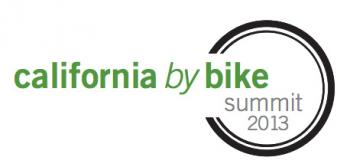 For me, California has always felt a little bit like home. I lived in Sacramento for nearly five years as a kid — where I rode around our neighborhood on my purple and gray Huffy. Since then, I’ve pedaled from the Northern California redwoods to the Golden Gate Bridge on Climate Ride in 2011 and had the privilege of launching the Women Bike initiative among a uniquely diverse group of local female leaders in Long Beach in 2012.
For me, California has always felt a little bit like home. I lived in Sacramento for nearly five years as a kid — where I rode around our neighborhood on my purple and gray Huffy. Since then, I’ve pedaled from the Northern California redwoods to the Golden Gate Bridge on Climate Ride in 2011 and had the privilege of launching the Women Bike initiative among a uniquely diverse group of local female leaders in Long Beach in 2012.
It seems that every time I head to the Golden State, I leave with new energy and inspiration. And I’m still buzzing from all the amazing connections and conversations I had last weekend at the California by Bike Summit.
What were some of the highlights?
Daring Goals, Diverse Leaders
Well, first of all, the California Bicycle Coalition has some incredibly bold goals. And their targets aren’t just quantitative, like doubling bicycling by 2017 and tripling ridership by 2020. They’re also qualitative: “Mainstream bicycling in California’s diverse culture.” Certainly audacious, but also attainable given the incredible, diverse leaders in the state — including a large number of women. 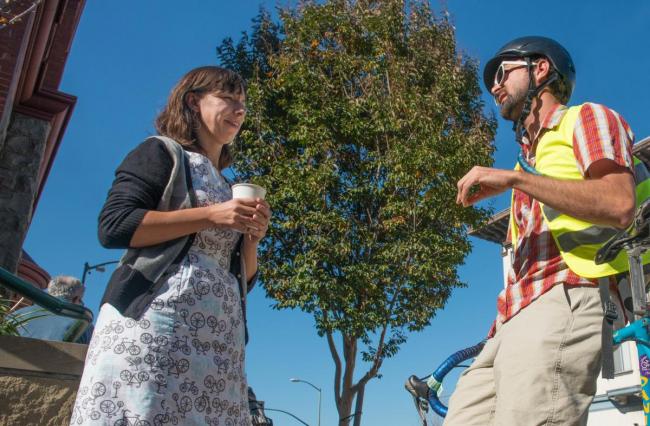
Left: CalBike board president Alexis Lantz (Photo by Allan Crawford)
It was impossible not to notice that the vast majority of leaders on stage for the plenaries were women. The most visible presenters, giving updates, sharing stories and making major announcements, included CalBike board president Alexis Lantz (a key catalyst for the formation of Women Bike), Jenna Burton (founder of Red, Bike & Green), Renee Rivera (Executive Director of the East Bay Bicycle Coalition), Cindy Parra (Bike Bakersfield), and Melissa Balmer (more on the Women on Bikes CA launch on Monday!).
Innovative Collaboration, Participatory Cities
In the very first session I attended, I was captivated by a collaborative project created by the University of Southern California, TRUST South LA and others. Francois Barr, a University of Southern California researcher, called the model “situated engagement” — rather than asking community members to come to a meeting, “take the workshop to the neighborhood and create some experiences that allow people to express the way their neighborhood works and doesn’t work.” Using mobile technology that could be used on any phone, residents were able to join a fun, social ride and document their local assets and deficits.
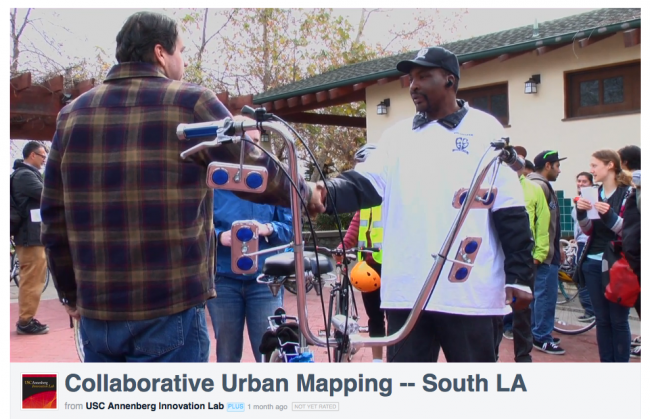
As Tafarai Bayne of TRUST South LA stressed, it essentially “put planning workshops in the streets” — streets where planners often don’t go. And, Bayne added, it indicated to the community that, yes, they deserve to be using cool, new technology to make their communities better. What resulted was more than a (incredibly cool) map but a whole new way of creating Participatory Cities — which is why the work was honored by the Guggenheim for the video above.
Development vs. Displacement
A related conversation tackled how bikes play a role in revitalization and displacement. The fear (and often fact) that gentrification comes quickly on the heels of better bike facilities is becoming an important issue in many cities. As Jenna Burton pointed out, it’s not necessarily the job of the bike movement to take on all the ancillary issues of housing and poverty and historic marginalization — but we do need to understand and respect the dynamics that exist. “If bike advocacy is truly committed to equity in bicycling,” Burton says, “then we have to be more cognizant of what that brings with it. Not to pretend we have all the solutions but find effective ways to support equitable development efforts and invest in local leadership that are already working on these issues.”
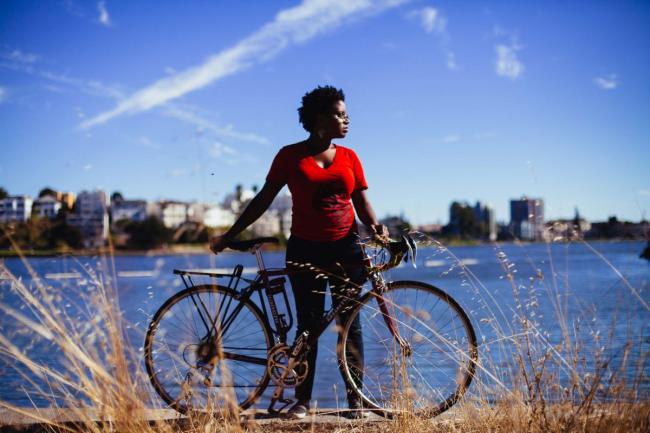 Jenna Burton, by Lisa Beth Anderson
Jenna Burton, by Lisa Beth Anderson
One term I’d never heard before but really resonated was “lived displacement” — a concept put forward by John Garrard Stehlin, a grad student at UC-Berkley. Even when residents are able to stay in their homes, what happens when the neighborhood character changes beneath their feet with shifts in retail and street life? That’s displacement, too. And we’re just at the beginning of this important discussion.
Redefining Mainstream
In a session called “Who is mainstream?” Miguel Ramos and Laura Torres from Multicultural Communities for Mobility in LA also stressed the importance of investing and partnering with community organizations that already exist. Ramos created a great visual showing how those already embedded groups are, in fact, the spokes that connect the community members to advocacy engagement.
Miguel Ramos and Laura Torres of MCM
That balanced model was evidenced in MCM’s work (then embedded in LACBC) with day laborers directly to create a Spanish language PSA — watch a great behind-the-scenes video of the process here. They not only connected with participants through a local day labor center but also made connections for those folks to other community resources, like an area bike co-op. Ramos and Torres stressed that, by giving recognition to those in the community who are already riding and providing education through existing networks, that partnership mentality has made MCM’s bike safety outreach successful, as well. MCM tailors its classes to the audience, as well, not only teaching the rules of the road but highlighting the local laws and rights of cyclists — critical for undocumented riders who may be more likely to be stopped by police. And the learning isn’t a one-way street; it’s revealed common misperceptions that day laborers are strictly riders of necessity. “Many of them are undocumented people from little towns in Central America,” Ramos explained. “And [biking] is not only a factor of economics, but factor of culture —being eco-friendly is embedded in the culture.”
Planning + Play
And how cool is this?
James Rojas, an urban planner, artist and founder of the Latino Urban Forum, showed us his engaging strategy to help neighborhood residents and even city planners play with tiny toys to envision a better community. While experiencing a city is sensory and spatial, too often everyday citizens are disconnected from the planning process and even transportation officials work on a strictly schematic, two-dimensional level. With his Place It workshops, Rojas gives folks the opportunity to solve problems or bring to life their vision of the perfect city using art and interactive models. Liberated from the constraints of linear planning, participants are able to develop an understanding of how the use of space influences their experience of their community — and come up with ways to make it better.
Elevating Women
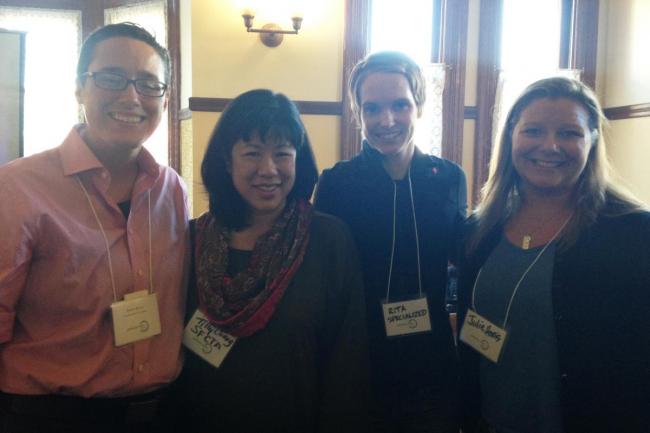
(From left) Renee Rivera, Tilly Chang, Rita Borelli, Julie Harris
Continuing that wider conversation about equity, Rivera led a panel on “Closing the gender gap in cycling leadership,” including great presentations from Tilly Chang (executive director of the San Francisco County Transportation Authority), Rita Borelli (Product Line Manager from Specialized) and Julie Harris from REI. I was particularly interested (and I’ll be following up with you, Julie!) on how REI has changed its hiring application process so that its less unintentionally weighted toward inherently male strengths — and has a stated goal of creating a workforce in their stores that is representative of the wider community. It was also encouraging to hear Chang highlight three characteristics that make women great leaders: we tend to be consensus builders; inclusive and community oriented; and have a personal commitment to our work.
Wendi Kallins of Marin County Bicycle Coalition and Nona Varnado, who started LA Bike Trains and a bicycle art gallery (among other endeavors) also carried forward the conversation about getting more women involved with their Building a Female Centric Bike Culture workshop. I was proud to see our Women on a Roll report in action during Kallins’ presentation (Read all about the 5 Cs here!) and was reminded by Varnado that, rather than feeling like we’re competing for perceived limited resources, women and women’s initiatives need to be focused on mentorship and collaboration. And she had this great gem, too:

That’s not all… Stay tuned Monday for a full blog on the launch of Women on Bike California!